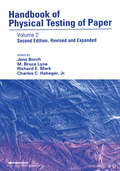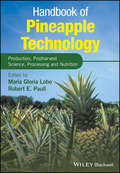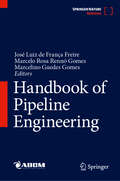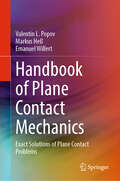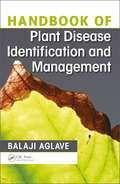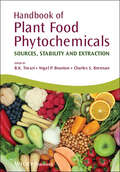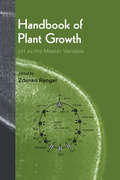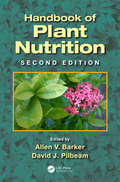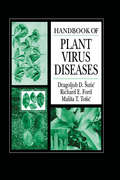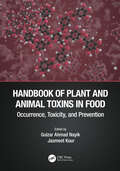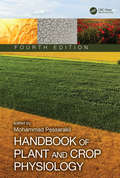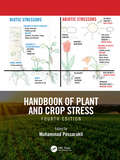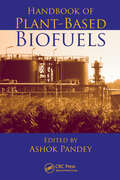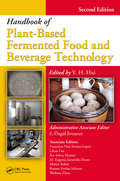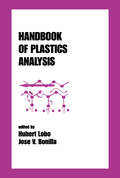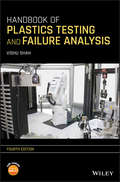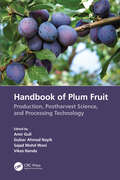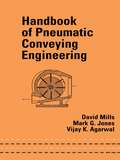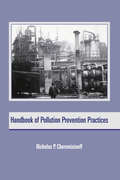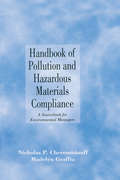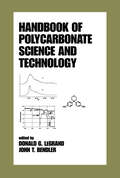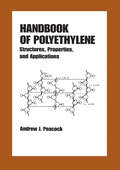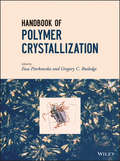- Table View
- List View
Handbook of Physical Testing of Paper: Volume 2
by Jens Borch M. Bruce Lyne Richard E. Mark Charles C. HabegerThis handbook focuses on physical paper testing in the laboratory and online. Divided into five parts, it highlights assays for paper interactions with light, moisture, electricity, and heat. Topics expanded upon include laboratory testing procedures; microscopy analysis and paper surface properties; liquid and gas penetration; electrical and thermal interactions; and methods of surface characterization.
Handbook of Phytonutrients in Indigenous Fruits and Vegetables
by Rajeev Bhat Michael Rychlik Hosakatte Niranjana Murthy Fozia Homa Víctor M Jiménez Mohammad Akhtaruzzaman Stephen Akinola Saleha Akter Mohammad Khairul Alam Adeyemi Oladapo Aremu Manjeshwar Shrinath Baliga Harish Kumar Bastimal Amina Benabdallah Tania Chacón-Ordóñez N.N.G. Chiranthika Daniel Cozzolino Maral Seidi Damyeh Patricia Esquivel Héctor Estrada-Medina Olaniyi Amos Fawole Mohsina Ferdous Miriam Monserrat Ferrer Selina Fyfe Cyrielle Garcia Nadaraj Govender Prasanna P. Gunathilake Ummai Habiba Chafik Hdider H.A.C.O Hettiarachchi Lee-Hoon Ho Riadh Ilahy Beguvalli Subash Inchara Sheikh Nazrul Islam G. Janarny Eugénie Kayitesi Helyes Lajos Vimbainashe E. Manhivi Florence M. Mashitoa Petunia Mashiane Bárbara Paes Mata Patricia Irene Montañez-Escalante Niranjana Moorthi Isabela Jacob Moro Mack Moyo Siphosanele Mafa Moyo Adaucto Bellarmino Netto Gabi Netzel Dr Michael Netzel Olubukola Motunrayo Odeyemi Abiodun Olusola Omotayo Miriam Ferrer Ortega Karkala Sreedhara Pai Karkala Usha Pai Giriyapura Srikantachar Pavankumar Zoltán Pék Elisa Dos Pereira Adaucto B. Pereira-Netto Anh Dao Phan Charlotte Ralison Vonimatra Razafindrazaka María del Ruenes-Morales Luis Vitor Sacramento Mateus Kawata Salgaço André Gonzaga Santos Horst Joachim Schirra Dr Mohammed Wasim Siddiqui Faith Seke Ambreen Naz Shah Md. Tariqul Shajib Kátia Sivieri Heather E Smyth Sukirtha Srivarathan Thuan-Chew Tan Imen Tlili Annegowda Hardur Venkatappa Juliana Vinholes Márcia Vizzotto Olivia Wright Guggalada Govardhana YadavThe effects of inadequate diets on the population include malnutrition, non-communicable diseases and obesity. 'Hidden hunger', also known as micronutrient deficiencies, leads to various health-related disorders and diseases. Indigenous plants, in the form of indigenous fruits and leafy vegetables are gaining interest as a source of nutrients and bioactive phytochemicals, satisfying both food demand and health needs. Moreover, with the impact of climate change, and the importance of sustainability of food systems, it is essential that we investigate new, forgotten and alternative crops that can thrive in harsh conditions, require low fertilizer input, and are easily harvestable. This book contains chapters on 33 understudied indigenous fruits and vegetables from all around the world, including African nightshade, amaranth, baobab fruit, Indian gooseberry, red bush apple and snake melon. Each chapter provides: An overview of plant botany. An understanding of the phytonutrient constituents and health-promoting properties of bioactive compounds or metabolites. Information on the biological activity of the functional compounds that will improve productivity and increase utilization of indigenous fruits and vegetables to sustain food security. Impacts of postharvest storage, processing, and traditional food preparation methods. Potential for new product development. This is an essential resource for academic researchers and industry professionals in the fields of horticulture, agriculture, crop science, human health and nutrition.
Handbook of Pineapple Technology: Production, Postharvest Science, Processing and Nutrition
by Maria Gloria Lobo Robert E. PaullPineapple is the third most important tropical fruit in the world, with production occurring throughout the tropics. The demand for low acid fresh pineapples and its processed products is one of the fastest growing markets, especially in Europe and North America. This book provides an in depth and contemporary coverage of knowledge and practices in the value chain of this popular fruit, from production through to consumption. The chapters explore all the most recent developments in areas such as breeding, novel processing technologies, postharvest physiology and storage, packaging, nutritional quality and safety aspects. An outstanding team of authors from across the globe have contributed to make this the definitive pineapple handbook. Handbook of Pineapple Technology: Production, Postharvest Science, Processing and Nutrition is the ultimate guide for scientists in the food industries specializing in fruit processing, packaging and manufacturing. It is also a useful resource for educators and students of food technology and food sciences as well as research centers and regulatory agencies around the world.
Handbook of Pipeline Engineering
by ABCM – Brazilian Society of Mechanical Sciences and Engineering José Luiz de França Freire Marcelo Rosa Rennó Gomes Marcelino Guedes GomesThis Handbook covers a large number of Pipeline Engineering topics, ranging from the initial stages of designing, constructing, operating and managing the integrity of a pipeline to several of their fluid transportation applications such as oil, gas, derivatives, slurry, hydrogen and CO2. Traditional onshore and offshore pipelines are covered, as well as chapters on present and future interaction with modern society. This Handbook serves as a first reference resource for new readers entering the field, but also as a complement to those who are aware of the general principles encompassing areas of pipeline engineering. This Handbook has been developed in close cooperation with ABCM, the Brazilian Society of Mechanical Sciences and Engineering.
Handbook of Plane Contact Mechanics: Exact Solutions of Plane Contact Problems
by Valentin L. Popov Markus Heß Emanuel WillertThe book contains a structured collection of complete solutions to all relevant plane contact problems. Classic profiles – such as the cylinder, the wedge, or the rectangular flat punch – are considered under centric and eccentric loading, but also a variety of other technically relevant shapes, such as the flat punch with rounded edges, the wedge with rounded tip, or wavy surfaces. With regard to the load configuration, adhesive and non-adhesive normal contacts, tangential contacts, and rolling contacts are considered. The materials considered are elastic isotropic, transversally isotropic, viscoelastic, and functionally graded media. The solutions given are derived in the simplest way available, and, in addition to the macroscopic relationships between load and contact configuration, include the stress fields in the surface and, where applicable, within the contacting bodies.
Handbook of Plant Disease Identification and Management
by Balaji AglaveHandbook of Plant Disease Identification and Management presents the fundamentals of plant diseases identification based on symptomology and management focusing mainly on integrated pest management approach. It discusses a variety of techniques for the diagnosis of crop disease, losses due to crop diseases, and theories behind disease management. It describes how society is constraining the possibilities for management of crop diseases by changing the environment; biologically controlling crop diseases; and the epidemiologic and genetic concepts of managing host genes. <P><P>This book discusses managing diseases through diverse chemical, biological, and physical methods. It highlights climatic factors affecting crops by creating favorable condition for most of the diseases. This book serves as a complete guide for growers, researchers, and graduate students to understand basics of plant disease identification. It explains the disease cycle for respective crops with favorable conditions promoting disease development. It intends to aid growers in managing diseases and help scientists with future research.
Handbook of Plant Food Phytochemicals: Sources, Stability and Extraction
by Nigel P. Brunton Charles S. Brennan B. K. TiwariPhytochemicals are plant derived chemicals which may bestow health benefits when consumed, whether medicinally or as part of a balanced diet. Given that plant foods are a major component of most diets worldwide, it is unsurprising that these foods represent the greatest source of phytochemicals for most people. Yet it is only relatively recently that due recognition has been given to the importance of phytochemicals in maintaining our health. New evidence for the role of specific plant food phytochemicals in protecting against the onset of diseases such as cancers and heart disease is continually being put forward. The increasing awareness of consumers of the link between diet and health has exponentially increased the number of scientific studies into the biological effects of these substances. The Handbook of Plant Food Phytochemicals provides a comprehensive overview of the occurrence, significance and factors effecting phytochemicals in plant foods. A key of objective of the book is to critically evaluate these aspects. Evaluation of the evidence for and against the quantifiable health benefits being imparted as expressed in terms of the reduction in the risk of disease conferred through the consumption of foods that are rich in phytochemicals. With world-leading editors and contributors, the Handbook of Plant Food Phytochemicals is an invaluable, cutting-edge resource for food scientists, nutritionists and plant biochemists. It covers the processing techniques aimed at the production of phytochemical-rich foods which can have a role in disease-prevention, making it ideal for both the food industry and those who are researching the health benefits of particular foods. Lecturers and advanced students will find it a helpful and readable guide to a constantly expanding subject area.
Handbook of Plant Growth pH as the Master Variable
by Zdenko RengelExplores the molecular, biochemical, functional, structural, and developmental mechanisms of pH in plant growth. Examines the role of pH in plant symplasm, plant apoplasm, thr rhizosphere, the ecosystem, and plant interaction with biotic snd abiotic environments.
Handbook of Plant Nutrition
by Allen V. Barker David J. PilbeamIn 2007, the first edition of Handbook of Plant Nutrition presented a compendium of information on the mineral nutrition of plants available at that time-and became a bestseller and trusted resource. Updated to reflect recent advances in knowledge of plant nutrition, the second edition continues this tradition. With chapters written by a new team o
Handbook of Plant Virus Diseases
by Dragoljub D. Sutic Richard E. Ford Malisa T. TosicHandbook of Plant Virus Diseases presents basic information about viral-caused and viral-like diseases in many cultivated crops. It provides authoritative descriptive symptomatic signatures of virus diseases to aid in the diagnosis and possible control of viruses. It organizes cultivated plants into groups according to their final destinations and uses after harvest - a useful grouping system that indicates that some diseases, their resultant epidemiology, and control measures are characteristic within different groups. It summarizes current knowledge about various virus-induced diseases in many economically important cultivated crops and addresses the need for an improved acronym system by presenting a new system that provides
Handbook of Plant and Animal Toxins in Food: Occurrence, Toxicity, and Prevention
by Gulzar Ahmad Nayik and Jasmeet KourThe prevalence of naturally occurring toxins in plant and animal foods represents one of the most significant food safety issues, drawing the attention of both scientists and regulators alike. This unexplored area related to food quality is indeed a big concern for consumers, various regulatory authorities, and food industries. Apart from essential nutrients, several food crops are capable of producing a vast array of nonnutritious secondary metabolic products. These toxins produced as secondary metabolites have the potential to exhibit both beneficial and deleterious effects in both human beings and animals. Nevertheless, there has been huge progress in agricultural practices and food processing technologies, but still the number of nonnutritive substances and naturally derived toxins persist in our diet. Handbook of Plant and Animal Toxins in Food: Occurrence, Toxicity, and Prevention, focuses on various selected toxins in foods derived from plants as well as animals. The prominent plant toxins include solanine and chaconine, mushroom toxins, phytates, tannins, oxalates, goitrogens, gossypol, phytohemagglutinins, erucic acid, saponins, cyanogenic glycosides, enzyme inhibitors, BOAA (lathyrogens), toxic amino acids and toxic fatty acids. The prominent animal toxins covered in the book include various seafood toxins, shellfish toxins and biogenic amines. Key Features: Presents complete information about a plethora of toxins Provides quick and easy access to data on major plant and animal toxins Covers distribution of toxins in the plant and animal kingdom Provides comprehensive information on chemistry, safety and precautions of each toxin Commencing with a brief introduction of food toxins, this book is designed in such a way that the readers will be introduced to toxicity, safety and occurrence of each toxin selected. It also discusses the in-depth detailed information on food poisoning and its prevention. The book will also shed light on foodborne illness associated with toxins. The primary audience for this work will be food scientists, food toxicologists, university scholars and college students. Furthermore, the book will be of immense help for public health officials, pharmacologists, and food safety officers who are involved with enforcing regulations meant to ensure the safety of a particular food
Handbook of Plant and Crop Physiology (Books In Soils, Plants, And The Environment Ser.)
by Mohammad PessarakliContinuous discoveries in plant and crop physiology have resulted in an abundance of new information since the publication of the third edition of the Handbook of Plant and Crop Physiology. Following its predecessors, the fourth edition of this well-regarded handbook offers a unique, comprehensive, and complete collection of topics in the field of plant and crop physiology. Divided into eleven sections, for easy access of information, this edition contains more than 90 percent new material, substantial revisions, and two new sections. The handbook covers the physiology of plant and crop growth and development, cellular and molecular aspects, plant genetics and production processes. The book presents findings on plant and crop growth in response to climatic changes, and considers the potential for plants and crops adaptation, exploring the biotechnological aspects of plant and crop improvement. This content is used to plan, implement, and evaluate strategies for increasing plant growth and crop yield. Readers benefit from numerous tables, figures, case studies and illustrations, as well as thousands of index words, all of which increase the accessibility of the information contained in this important handbook. New to the Edition: Contains 37 new chapters and 13 extensively revised and expanded chapters from the third edition of this book. Includes new or modified sections on soil-plant-water-nutrients-microorganisms physiological relations; and on plant growth regulators, both promoters and inhibitors. Additional new and modified chapters cover the physiological responses of lower plants and vascular plants and crops to metal-based nanoparticles and agrichemicals; and the growth responses of plants and crops to climate change and environmental stresses. With contributions from 95 scientists from 20 countries, this book provides a comprehensive resource for research and for university courses, covering plant and crop physiological responses under normal and stressful conditions ranging from cellular aspects to whole plants.
Handbook of Plant and Crop Stress, Fourth Edition (Books in Soils, Plants, and the Environment)
by Mohammad PessarakliSince the publication of the third edition of the Handbook of Plant and Crop Stress, continuous discoveries in the fields of plant and crop environmental stresses and their effects on plants and crops have resulted in the compilation of a large volume of the latest discoveries. Following its predecessors, this fourth edition offers a unique and comprehensive collection of topics in the fields of plant and crop stress. This new edition contains more than 80% new material, and the remaining 20% has been updated and revised substantially. This volume presents 10 comprehensive sections that include information on soil salinity and sodicity problems; tolerance mechanisms and stressful conditions; plant/crop responses; plant/crop responses under pollution and heavy metal; plant/crop responses under biotic stress; genetic factors and plant/crop genomics under stress conditions; plant/crop breeding under stress conditions; empirical investigations; improving tolerance; and beneficial aspects of stressors. Features: Provides exhaustive coverage written by an international panel of experts in the field of agriculture, particularly in plant/crop stress areas Contains 40 new chapters and 10 extensively revised and expanded chapters Includes three new sections on plant breeding, stress exerted to weeds by plants, and beneficial aspects of stress on plants/crops Numerous case studies With contributions from 100 scientists and experts from 20 countries, this Handbook provides a comprehensive resource for research and for university courses, covering soil salinity/sodicity issues and plant/crop physiological responses under environmental stress conditions ranging from cellular aspects to whole plants. The content can be used to plan, implement, and evaluate strategies to mitigate plant/crop stress problems. This new edition includes numerous tables, figures, and illustrations to facilitate comprehension of the material as well as thousands of index words to further increase accessibility to the desired information.
Handbook of Plant-Based Biofuels
by Ashok PandeyExplores Worldwide Trends Involving the Production and Use of BiofuelsWith the depletion of oil resources as well as the negative environmental impact of fossil fuels, there is much interest in alternative energy sources. Focusing on some of the most important alternate energy sources for the foreseeable future, the Handbook of Plant-
Handbook of Plant-Based Fermented Food and Beverage Technology
by Y. H. HuiFermented food can be produced with inexpensive ingredients and simple techniques and makes a significant contribution to the human diet, especially in rural households and village communities worldwide. Progress in the biological and microbiological sciences involved in the manufacture of these foods has led to commercialization and heightened int
Handbook of Plastics Analysis
by Hubert Lobo Jose V. BonillaPlastics possess properties that have revolutionized the manufacture of products in the 20th century and beyond. It remains critical to understand their behavior throughout their life cycle, from manufacture to use and eventually to reclamation and disposal. This volume highlights the most prominent tools in physical and chemical analysis techniques and applications. A practical reference for performing measurements, solving problems, and investigating behavioral phenomena, the editors advocate a phenomenological approach, relying on case studies and illustrations to represent possible outcomes of each technique and presenting the basic governing equations where necessary.
Handbook of Plastics Testing and Failure Analysis (Society Of Plastics Engineers Monographs #21)
by Vishu ShahWritten in easy-to-read and -use format, this book provides a strong training resource and reference for product designers using plastics in their products – helping them identify, quantify, and confirm whether problems are related to product design or process.• Updates coverage of data analysis techniques and examples and expands coverage of failure analysis, key because of increased litigation related to product liability• Overviews plastic testing methods and the framework to investigate causes of plastic part failure• Provides a strong training resource and reference for product designers using plastics in their products• Features a video tour of a plastics testing labroatory on a companion website and has a separate manual of problems and solutions that are appropriate for college professors using the book as a class textbook
Handbook of Plum Fruit: Production, Postharvest Science, and Processing Technology
by Gulzar Ahmad Nayik Amir Gull Sajad Mohd Wani Vikas NandaIn the last ten years there has been an exponential increase in the adoption of high-density farming, which leads to better yield and higher-quality fruits, thus improving the economic return. Handbook of Plum Fruit: Production, Postharvest Science, and Processing Technology covers all the recent advances in plum production, harvesting, handling and processing. Divided into two main parts, the first eight chapters provide insight about preharvest processing of plums, whereas the later chapters discuss the postharvest processing of plums. This book also includes vital chapters on varietal improvement and rootstock breeding, high-density planting, and pollination. After harvesting, plum quality quickly diminishes, mainly due to weight loss, total acidity, loss of firmness, and decay. Key Features: • In-depth information on the pre- and postharvest processing of plums • Coverage on plum harvesting, handling, and storage practices • Plum by-product utilization and potential health benefits Handbook of Plum Fruit provides comprehensive information on recent advances in postharvesting technologies of plum. The health benefits of plum and its products are also addressed. This book will assist horticulturists, agriculturists, pomologists, food scientists and others working in various fruit-processing industries.
Handbook of Pneumatic Conveying Engineering (Mechanical Engineering Ser. #Vol. 165)
by David Mills Mark G. Jones Vijay K. AgarwalPneumatic conveying systems offer enormous advantages: flexibility in plant layout, automatic operation, easy control and monitoring, and the ability to handle diverse materials, especially dangerous, toxic, or explosive materials. The Handbook of Pneumatic Conveying Engineering provides the most complete, comprehensive reference on all types and s
Handbook of Pollution Control and Waste Minimization
by Abbas Ghassemi"Details the legal, organizational, hierarchical, and environmental components of pollution prevention and waste reduction. Illustrates fundamental concepts of pollution prevention, including life-cycle planning and analysis, risk-based pollution control, and industrial ecology."
Handbook of Pollution Prevention Practices (Environmental Science & Pollution)
by Nicholas P. CheremisinoffThis text provides approaches and methodologies for implementing pollution prevention (P2) and waste minimization programmes to reduce manufacturing operational costs significantly. It focuses on reducing manufacturing and environmental compliance costs by instituting feedstock substitution, improved operational schemes, recycling and by-product re
Handbook of Pollution and Hazardous Materials Compliance: A Sourcebook for Environmental Managers (Environmental Science & Pollution)
by Nicholas P. Cheremisinoff Madelyn GraffiaOffers a guide to current environmental health and safety statutes--providing a working knowledge of the major legislations and regulations and demonstrating the steps necessary for compliance. Illustrates overall health and safety management skills for multimedia facilities.
Handbook of Polycarbonate Science and Technology (Plastics Engineering #Vol. 56)
by Donald G. Legrand John T. Bendler"Summarizes research and progress in understanding the fundamental molecular properties of polycarbonates by covering history, theory, modeling, and spectroscopy. Offers the first comprehensive survey of polycarbonates in over 30 years."
Handbook of Polyethylene: Structures: Properties, and Applications (Plastics Engineering)
by Andrew PeacockThis text provides the basic history, molecular structure and intrinsic properties, practical applications and future developments of polyethylene production and marketing - including recycling systems and metallocene technology. It describes commercial processing techniques used to convert raw polyethylene to finished products, emphasizing special
Handbook of Polymer Crystallization
by Ewa Piorkowska Gregory C. RutledgePolymeric crystals are more complex in nature than other materials' crystal structures due to significant structural disorder present. The only comprehensive reference on polymer crystallization, Handbook of Polymer Crystallization provides readers with a broad, in-depth guide on the subject, covering the numerous problems encountered during crystallization as well as solutions to resolve those problems to achieve the desired result. Edited by leading authorities in the field, topics explored include neat polymers, heterogeneous systems, polymer blends, polymer composites orientation induced crystallization, crystallization in nanocomposites, and crystallization in complex thermal processing conditions.
